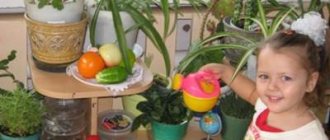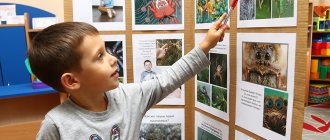Set 14 – Arches and numbers
The child gets acquainted with unusual shapes from which he can assemble a circle of different diameters. He compares sizes and learns the concept of “proportion.”
Guidelines for kit 14
Recommended for children over 5 years old.
- Round figures will help make houses made of cubes more rounded and introduce a new architectural form into the overall composition.
- Separate circle segments allow you to create circles of different sizes and count the number of resulting rings and rounded parts in each.
- The cubes can be strung onto the bar from set 2 and used as abacus.
What does it contain?
- 9 cubes with numbers.
- 3 identical sets of circles, divided into quarter circle and ring segments.
Who will benefit from the set?
The play set is intended primarily for kindergartens. It can be used in preparation for school, for all-round development.
Froebel's technique is successfully used by psychologists who note improvements in mental activity, attention, perseverance, and the ability to compare and analyze.
Speech therapists also practice “gifts” in order to improve fine motor skills and enrich tactile sensations. This stimulates areas of the brain that affect speech. Pronouncing words helps to expand your vocabulary.
Froebel's technique is effective in the work of defectologists. It is used to work through problematic aspects of development and restore lost physical and intellectual skills. Froebel's gifts are part of the state's adaptive Accessible Environment program.
Minuses
Like any preschool education system, Froebel's method has its drawbacks. Let's talk about some of them, recalling that they are all subjective, just like the advantages.
The first is clear regulation of the activities of a preschooler. Unlike other education systems, the child is not allowed to be fully independent. And many parents don't like this. Firstly, the child has to pay more attention (you have to keep an eye on what your son or daughter is doing all the time). Secondly, not all kindergartens in Krasnoyarsk can offer you training using this method. In these preschool institutions, the child will most likely be left to his own devices for quite a long time, which contradicts the essence of the system.
The second is educational material and low performance. If you believe the main idea, then games with folding paper, exercises with a ball or a wooden construction set should develop the child. Their benefits, of course, are undeniable, but teachers have doubts: are such exercises enough for good results?
Third, the child does not grow up to be independent. This contradiction is felt most strongly. On the one hand, we develop a harmonious personality, distribute the child’s free time entirely, but the lack of independent leisure time based on interests also has a downside. He will be able to make decisions, be responsible for his actions, but only for those that others have pointed out to him.
Formation of the Froebel system of pedagogical education for preschoolers
Under these conditions, Friedrich Froebel and his Swiss teacher Johann Pestalozzi came to pedagogy. Pestalozzi, based on the educational ideas of the existence of natural laws of nature, creates the first holistic concept of raising children. According to him, the task of pedagogy is to raise and educate a child in accordance with human nature, expressed in the abilities to think, create and feel. This was a radical break with previous Christian teaching, which considered it necessary to subordinate the potentially sinful nature of man to its picture of the world. Froebel, who taught and simultaneously studied at Pestalozzi’s school for two years, transferred his ideas to the soil of the German idealism of Kant and Fichte.
Froebel's pedagogical ideas were not immediately in demand. At first, like any innovator, he encountered resistance from the German teachers and the state, who accused him of nothing less than condoning atheism. More of an inventor and teacher, Friedrich Froebel was not a very good popularizer of his method. Because of this, his career experienced ups and downs, and he himself moved from one part of Germany to another. Along with him, his kindergartens, which opened and closed, could not settle. Only after Froebel's death did his pedagogical ideas gain recognition. In 1859, seven years after the death of the teacher, the Froebel Society emerged in Berlin, which was engaged in the dissemination of this system.
A special contribution to the popularization of kindergartens was made by Lina Morgenstern, a children's writer, teacher and figure in the German feminist movement of that time. During this period, issues of preschool education, universal school education, women's and labor issues were considered by progressive minds as links in the same chain of economic and political backwardness, so it is not surprising that pedagogical reformers took an active position on other flashy issues of our time.
In 1860, Morgenstern wrote the book “Childhood’s Paradise” - the first systematic textbook on Froebel’s method. Gradually, this method conquers all of Germany, becoming the national German preschool education system, and then begins to spread throughout the world. The second half of the 19th century was a time when German schools and kindergartens were considered exemplary; they were seen as the key to Germany’s economic success. The countries in which there was a strong Germanophile tradition of importing intellectual innovations, including Russia, were most influenced by German pedagogical ideas. Domestic pedagogy, which was born at the same time, was greatly influenced by Froebel’s ideas, and his followers were called Froebelians here.
pros
The first and undoubted advantage is the scientist’s contribution to the institute of preschool education. With its help, kindergartens have taken a leading position in the preschool education system in many countries. The great teacher created a holistic methodology, equipped it with practical aids and brought it to life.
The second plus is maximum attention to the child. One way or another, parental attention is worth a lot. It’s good if you spend maximum time with your baby, but not all parents adhere to this rule - and it doesn’t really matter what development system you follow.
The third plus is followers. Over the years of the existence of the methodology, others have arisen on its basis; Froebel’s works still remain relevant and are used in preschool education, which means that it makes sense to use its provisions for the upbringing and development of one’s own children.
Pedagogical ideas of Friedrich Froebel
The expression “kindergarten” belongs to the German educator Friedrich Froebel and was coined in 1840 to designate his then revolutionary preschool institution in Thuringia. Froebel used the word "garden" because he compared children to delicate garden plants that grow only through the conscious and tireless efforts of gardeners. Actually, the essence of this metaphor is not in children - the flowers of life - but in the need for good gardeners and educators for children's development. The idea for the first half of the 19th century was non-trivial: the then views on childhood as a special stage in a person’s maturation were not distinguished by either breadth or any particular sophistication. Most of the orphanages belonged to the church (Catholic or Protestant), discipline and obedience reigned in them, coupled with obligatory prayers and the hypocrisy inherent in this method of education. The need for a teaching profession was not obvious.
Here it is worth making a digression and recalling that the very idea of childhood is an invention of the New Age. As the French historian of family and family life Philippe Ariès notes, until the 17th century, a child was perceived as a “little adult.” Both peasants and kings did not have any taboos on information or relationships between people in the presence of children. First of all, this concerned such topics that are now half-hidden for children, such as death and sex. Regarding the latter, it was believed that until puberty, children were simply not interested in this, but adults should not deny themselves. By the mid-17th century, Catholic and Protestant moralists were able to reverse this Pantagruelian medieval spontaneity in favor of the Christian idea of the purity and sanctity of childhood. The concept of childhood as a special state of a person is conquering minds, but this concept was devoid of movement. The child was seen by religious teachers as a being without passions and sins. The Baby Jesus from icons and Renaissance paintings is the ideal child. Of course, the inquisitive child’s mind, exploring the world, constantly destroyed the static ideal, and rods and other methods of discipline were used. Here we can recall the classic literary character Tom Sawyer, who is interested in wandering around the outskirts of his town, while his Sunday school teachers try to make him live through pictures and verses of Scripture. If the medieval “little adult” participated in human society on an equal basis with the elders, without making allowances for age, then the modern child is generally denied such participation.
Examples of exercises with “Froebel's Gifts”
"Flower Factory" Using kits, children place their favorite flower on the table for their mother, sister or grandmother. Then the resulting drawing must be sketched in a notebook. In this case, you need to accurately repeat the shapes and colors.
"What's in the bag?" The teacher shows and places 3 multi-colored balls in a bag. Then the child takes out only 2 balls. The player’s task is to determine what color the ball remains in the bag.
"Miracle snake." The teacher strings figures of different shapes and colors onto a string, creating a long snake. The children’s task is to repeat the pattern exactly, maintaining the sequence of colored figures. The lesson starts with an easy pattern and gradually moves on to more complicated ones.
Popular questions from parents
You are being advised by child psychologist Yulia Viktorovna Buyanova.
What do you see as the main advantages of this technique?
“The undoubted advantage of this method is attention to the child, his needs and individual abilities. And joint activities with parents ensure psychological comfort and development of each family member, establishing strong connections and mutual understanding.”
What disadvantages of the technique can you note?
“Froebel’s methodology had a huge impact on the development of preschool pedagogy and became widespread. However, in its original form it does not correspond to the level of technological development and the speed of our time.”
Why do you think this method is not as popular today as, for example, Montessori?
“It should be noted that Froebel was the founder of sensory education. At the same time, Maria Montessori actively used sensory exercises to develop thinking, feelings, sight and sound. Also, Froebel’s method regulates the activities of children in the greatest possible way, in contrast, the Montessori method is aimed at the fact that the teacher only observes the process, creating for the child an environment for multifaceted development.”
We hope that our article has helped you to better understand this system of education for preschoolers. You can use some of it for the development of your children, creating your own method for upbringing and education.

